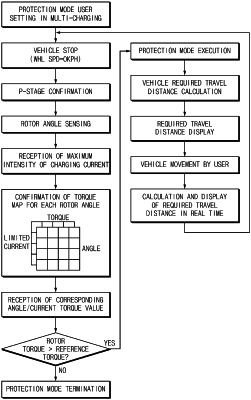| CPC B60L 53/122 (2019.02) [B60L 50/51 (2019.02); H02P 6/185 (2013.01); B60Y 2200/92 (2013.01)] | 16 Claims |

|
1. An apparatus for controlling charging of an electric vehicle, the apparatus comprising:
a quick charge determination module configured to compare a voltage level of a charging power source supplied from electric vehicle supply equipment (EVSE) with a level of a voltage standard received from a high-voltage battery provided in the electric vehicle to determine whether to directly supply or boost supply of the charging power source;
an inverter configured to boost the voltage of the charging power source supplied from the electric vehicle supply equipment to a specified level or more and provide the boosted voltage to the high-voltage battery when the voltage level of the charging power source supplied for quick charging is less than the voltage standard;
a driving motor provided with a stator three-phase coil receiving the charging power source from the electric vehicle supply equipment; and
a protection mode control module configured to calculate rotor torque that is generated during charging based on an angle of a rotor provided in the driving motor before the quick charging, and induce the rotor torque to be less than a preset reference torque,
wherein the protection mode control module includes:
a charging preliminary information reception device configured to receive vehicle stop information, the angle of the rotor provided in the driving motor, and an intensity of a charging current of the battery before charging as preliminary information for determining whether to charge;
a protection mode execution determining device configured to compare the rotor torque with the preset reference torque to determine whether to execute a protection mode after calculating the rotor torque expected to occur during the charging based on the angle of the rotor and the intensity of the charging current of the battery; and
a memory configured to pre-calculate and store a magnitude of the reference torque that deteriorates or damages a parking sprag.
|
|
9. A method of controlling charging of an electric vehicle, the method comprising:
boosting a voltage of a charging power source to a specified level or higher and supplying the boosted voltage when a voltage level of the charging power source supplied from electric vehicle supply equipment (EVSE) is less than a voltage standard received from a high-voltage battery provided in the electric vehicle, otherwise determining to supply the voltage of the charging power source directly to the high-voltage battery;
receiving vehicle stop information, an angle of a rotor provided in a driving motor, and an intensity of a charging current supplied to the battery as preliminary information for determining whether to charge before charging is performed;
determining whether to execute a protection mode by comparing a rotor torque with preset reference torque after calculating the rotor torque expected to occur during charging based on the angle of the rotor and the intensity of the charging current;
calculating, as a protection distance, a required travel distance of the electric vehicle required to correct the angle of the rotor such that the rotor torque, which is expected to occur during the charging, is reduced to less than the reference torque when it is determined to execute the protection mode; and
displaying a result of a determination to execute the protection mode in the determining of the protection mode execution and the protection distance calculated in the calculating of the protection distance through an audio video navigation (AVN) module so that a driver recognize the result and the protection distance.
|